|
– Part 2: Films 5-8 –
| THE TICKET OF LEAVE MAN (1937) |
|
Of all the titles in this glorious set, The Ticket of Leave Man must be the most potentially bemusing to a modern audience. When I first saw it, the first thought that went through my head was "Well, they're all English words, but…" It took a quick bit of research to clarify even how the title should be inflected, let alone what it meant. I mean, are we talking about a ticket owned by something called a 'Leave Man'? Apparently not. A Ticket of Leave, according to Dictionary.com, was "a permit allowing a convict to leave prison, under certain restrictions, and go to work before having served a full term, somewhat similar to a certificate of parole." Other sources suggest that it was primarily used for convicts who had been shipped off to British colonies like Australia. Here, the prison in question is on home soil.
The film opens at night outside the gate of a wealthy woman named Mrs. Peyton, to which celebrated detective Hawkshaw (Robert Adair) arrives with the news that a notorious criminal known as The Tiger (Tod Slaughter) is known to be in the district. In a nice bit of localised language he informs a beat policeman that, "one of my narks blew the gaff." He then warns that The Tiger is here to steal Mrs. Peyton's jewels, and that he'll garotte her if he enters her abode. "Remember, he's the most dangerous killer in London," he tells his men, a statement that is then nicely underscored by a loud female scream from within the house. Hawkshaw and his boys run around the back to intercept The Tiger, who fools them by exiting via patio doors at the front. Using the aforementioned garotte, he throttles the unfortunate beat policeman who's been left out front and coshes the detective who runs to his aid. By the time Hawkshaw and his remaining men arrive to assist, The Tiger has departed to the sound of Slaughter's signature cackle.
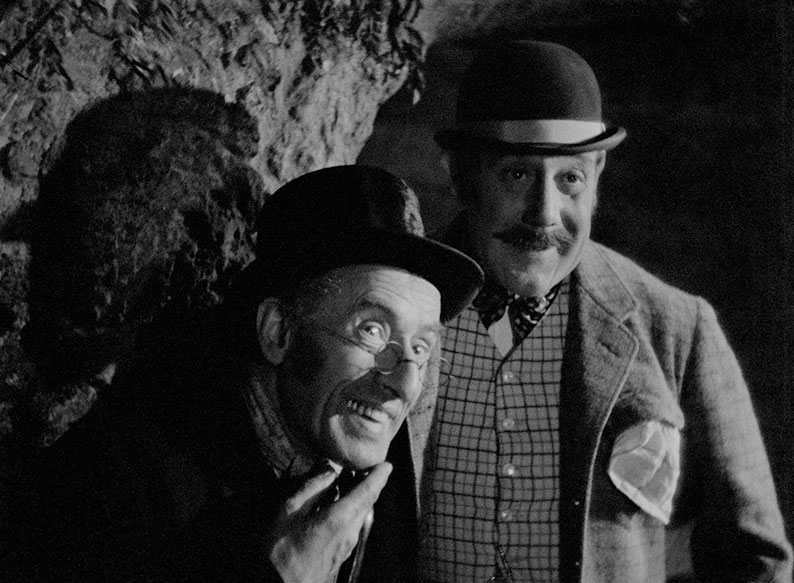
The next time we clap eyes on both men is at a bustling pleasure garden the following evening. Hawkshaw and his lead detective are on the lookout for The Tiger, even though neither of them knows what he looks like or, as far as I can tell, have any reason to suspect that he'll be there tonight. But by golly he is, as we discover when he sits down with his associate, Melter Moss (Frank Cochran), and oh boy, are we going to have to talk about this individual. Looking back at films made in less enlightened times can often present a modern viewer with ethical issues, but I can think of no other character in this box set who gave me more of those than Mr. Moss. In the commentary, Dave Thomas describes him as "slightly unfortunate racial stereotyping." I'd suggest it's a little bit more than slightly unfortunate. At a time when antisemitism is worryingly on the rise again, to encounter a character who is this wincingly close to a fascist cartoon image of a cooked and creepily avaricious Jew, complete with a whiny nasal voice, a praying mantis stoop, and an "oi vey, my boy" accent, delivers a most discomforting jolt. I get that this was a different time and that we have to make allowances, but I really struggled here. Considering how appalling things already were for Jews in Germany at the time of this film's release, every time Moss makes an appearance, I found myself cringing.
Anyway, where was I? Oh yes. As well as dropping in on Moss and forcing him to buy a bottle of champagne for ten shillings and sixpence (how much?), The Tiger has come to the pleasure garden to hear the delectable May Edwards (Marjorie Taylor) sing. Unfortunately for him, he has a younger, more handsome rival in the shape of Bob Brierly (John Warwick), whom May is already in love with. Bob is in fine spirits, having just been promoted, a rise he celebrates by also buying a bottle of champagne. No wonder the waiter is smiling tonight. The Tiger sidles up to Bob while May is singing and asks for a light, and while Bob is distracted he swaps the five £10 bank notes in Bob's pocket for ones forged by Moss. He then invites Bob to join him for a smoke, and they head over to a cigar stand owned by Mrs. Willoughby, who's played by Tod Slaughter's wife, Jenny Lynn. While she's busy elsewhere, the stall is run by her grandson, Sam, played by a young lad named Arthur Payne, who only has two movie credits and should have had far more. A preteen with the cocksure confidence of a 20-year-old East End barrow boy, Sam's every appearance put a wide smile on my face, though those who worry about the welfare of children on movie sets may well balk at the sight of him taking satisfied puffs on a cigar. Moss tips Hawkshaw off about the forged notes and Bob is quickly arrested, and it struck me that The Tiger really missed a trick here. When Moss tried to sell the notes to him, he assured him that they were such good forgeries that "the Governor of the Bank of England wouldn't know the difference." Yet when Bob is arrested, it takes Hawkshaw no more than a second to identify them as fake. Moss was trying to con you with those forgeries, mate. I'd sort him out now instead of working with him further.
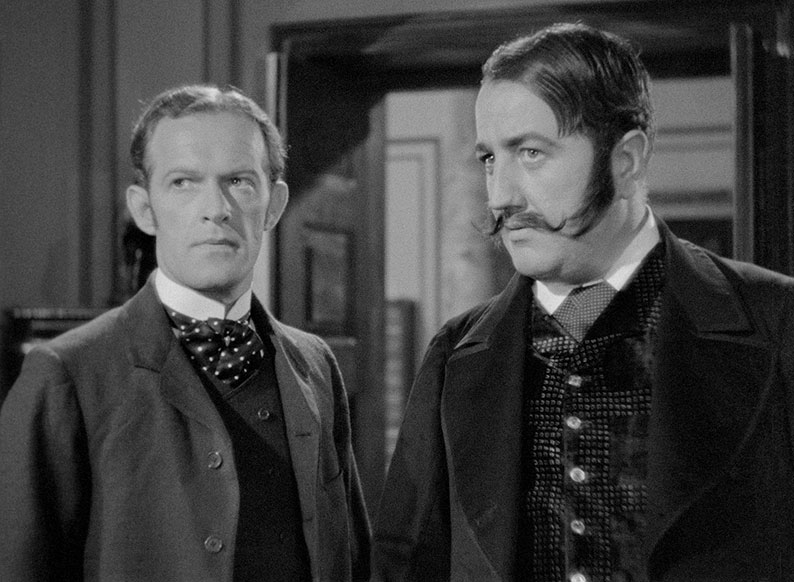
A link to It's Never Too Late to Mend comes when the colleagues of a waiter named Jackson (Billy Bray) are outraged to discover he is a former jailbird and head waiter Maltby (Norman Pierce) thus fires him on the spot. This leads to the film's first slice of social commentary when Jackson spots Tiger picking George's pocket and attempts to inform Maltby but is dismissed out of hand and sent on his jailbird way. Having tried to do the right thing and been rudely rebuffed, he instead turns back to crime and tries to blackmail the man he saw swapping the notes, painfully unaware that he is The Tiger. Try to guess how that goes. When his body is discovered, pandemonium breaks loose and Hawkshaw locks the place down, but when May falls into a faint, The Tiger picks her up and bluffs his way through the barrier in the guise of a rescuer of weakened women. A short while later he demonstrates for us what an absolute cad he really is by resting the unconscious May in a street doorway and giving her a serious snog before departing. Damn, Slaughter really did relish playing the bad guy. But there's more.
With George carted off to jail for a crime he didn't commit, The Tiger reinvents his image as Mr. Pybus, the head of The Good Samaritan Help Society, which he claims exists to financially and spiritually assist those who have just been released from Her Majesty's prisons. It's all bullshit, of course, just a ruse to wheedle money out of a rich ageing widows. It gets worse. When his latest elderly mark thanks him for his work and leaves his office, The Tiger calls for his assistant, whom he has nicknamed Ugly (an uncredited Harry Terry) and who enters via a secret passage behind the bookcase. I have so many questions about this. The Tiger then implies Ugly should go to this frail old woman's home and scare her to death so he can collect the money she has left to his organisation in her will.
It's also in his new guise that The Tiger has been providing financial aid to May in an effort to win her heart, or more accurately, her body. When she visits him, he misses no opportunity to manhandle her or forcibly kiss her. But she politely but firmly declines, and reaffirms her commitment to marry Bob Brierly as soon as he's released. And what do you know? Despite being wrongly convicted and having good reason to kick up a stink, Bob has been a model prisoner and is thus being set free early on the titular ticket of leave. Reunited with her beau and faced with the then toxic public prejudice against former prisoners, May introduces him to her friend, Joshua Gibson (Peter Gawthorne), and her brother and secures him a post at Gibson's bill brokerage business. Bob does so well at the job that Gibson decides to make him his confidential clerk, a post that comes with an increase in salary, a mirror reflection of his situation before he was fitted up by The Tiger. Bob hates deceiving Gibson about his true identity but knows that if the truth came out that he would lose his new position. Of course, that's when The Tiger, in his Mr. Pybus guise, enters the bank and spots Bob expressing his concerns to May, and immediate starts making plans to nobble him once again.
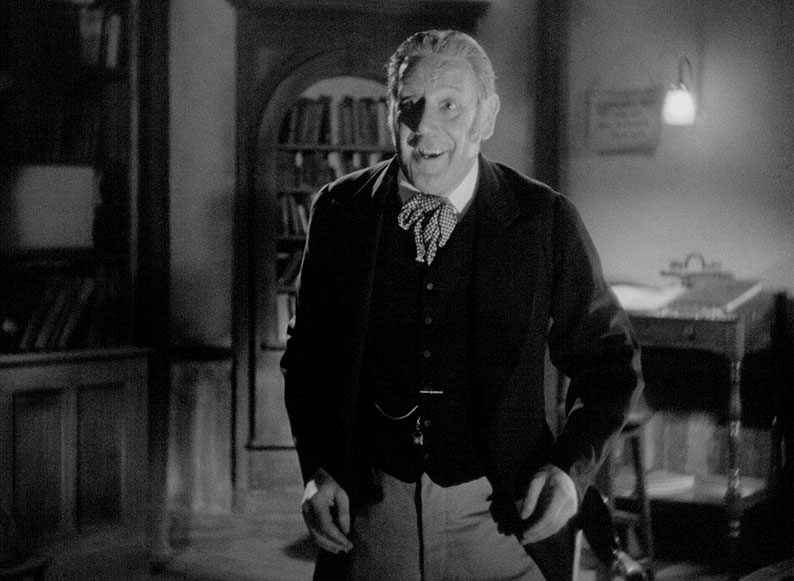
Adapted by H.G. Malby and A.R. Rawlinson from the play of the same name by Tom Taylor, The Ticket of Leave Man is a fascinating melding of melodrama and social issue cinema. It doesn't kick as hard as its immediate predecessor, but benefits from a more smoothly developed storyline, and you could argue that it more successfully incorporates these social concerns into the central narrative. The firing and subsequent fate of the pleasure garden butler neatly foreshadows the dilemma facing Bob once he finds himself similarly ostracised, and in doing so the film follows through on a social issue raised in its immediate predecessor. John Warwick makes Bob the most engaging of the handsome heroes in this collection, and I'd personally be happy to watch a whole series of films featuring Robert Adair as the redoubtable Hawkshaw. Slaughter, of course, is once again in his element as The Tiger, able to intimidate Moss without raising his voice or breaking his smile, but letting rip once he makes the decision to torch his office, an act that has him cackling wildly and behaving very badly. It builds to a pacy finale, albeit one that ultimately reruns Slaughter's favourite one-against-many climactic confrontation for the third time in a row. It's still a hugely enjoyable work. If only it wasn't for the unfortunate Moss…
| SEXTON BLAKE AND THE HOODED TERROR (1938) |
|
If you're in your 30s or younger, there's a decent chance you've never heard of fictional detective Sexton Blake. On paper, that might seem a little astonishing, as according to his Wikipedia page, he appeared in over 4,000 stories written by 200 different authors over the course of an 85-year run. But the last time any of these tales was adapted for a screen of any size was in 1978 with the six-part BBC serial, Sexton Blake and the Demon God. Being a bit of an oldie, my exposure to him came earlier with the four-season ITV series Sexton Blake, which first aired between 1967 and 1971 and starred Laurence Payne as the titular detective. I was very young then, but remember enjoying them, much as I enjoyed Batman, The Avengers, or anything connected with a certain Mr. Sherlock Holmes.
Ah yes, Mr. Holmes. Although Blake didn't start out as an alternative Holmes, writers soon began aligning him with Conan Doyle's still much-beloved consulting detective, although Blake was always a more action-orientated investigator. Where Homes would search for further clues, Blake would solve cases by getting in there and beating the bad guys up. Several film and serial adaptations of Sexton Blake stories appeared in the silent era, and in the 1930s, with the arrival of the talkies, three more were adapted for the big screen, all starring George Curzon as Blake and Tony Sympson as his young assistant, Tinker. The third of these was Sexton Blake and the Hooded Terror, whose villain is played by that master of the craft, Tod Slaughter. And frankly, it's one of his best performances in one of his most polished and enjoyable films.
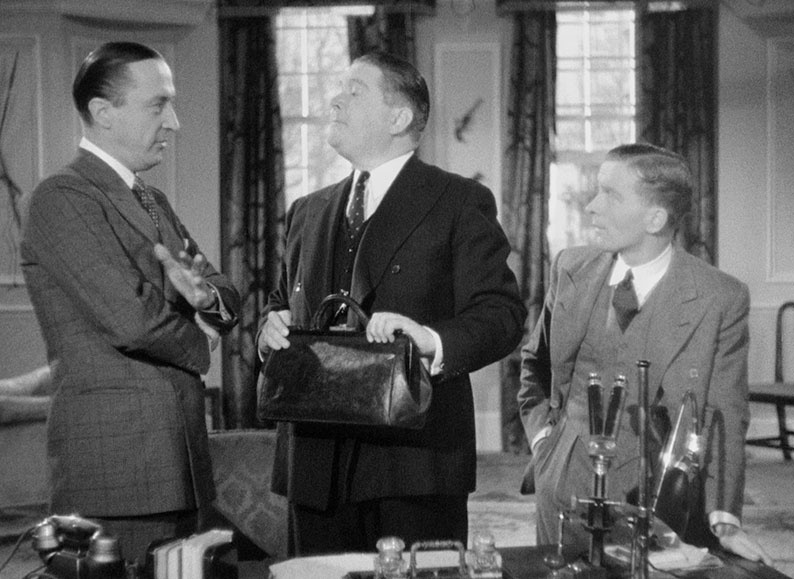
It starts in the Far East, where a man named Granite Grant is seriously wounded in a murder attempt carried out by two Chinese operatives on behalf of a black robed and hooded criminal mastermind known as The Snake, the head of an organisation known as the Black Quorum. Grant is played by David Farrar, a then bit part player whose star would later shine with more prominent roles in classic works such as Cavalcanti's Went the Day Well? (1942), and Powell and Pressburger's Black Narcissus (1947) and The Small Back Room (1949). He would also get play Sexton Blake himself in two highly regarded 1945 movies, Meet Sexton Blake! And The Echo Murders.
Confined to his bed on doctor's orders, Grant tells his associate, Paul Duvall (Bradley Watts), to head to London and deliver a message to Sexton Blake. It's then that we meet Blake, and if you weren't already aware of the Holmes association, the next couple of minutes would leave you in no doubt. Blake, with his hair slicked back and dressed in a smoking jacket, is reclining in a chair in his living room surveying his stamp collection and smoking a pipe whilst conversing with Mrs. Hudson stand-in, Mrs. Barnell (Marie Wright), while his slightly bumbling male assistant carries out an explosive experiment in the room next door. Blake and Tinker even rent rooms in Baker Street, for pity's sake! Yet having clearly established the links between Blake and Holmes, the film then sets about showing how the two detectives differ. For a start, Tinker is barely out of teens, though it's worth remembering that Dr. Watson was estimated to be about 28 in the first Homes story, A Study in Scarlett. Despite her advanced years, Mrs. Barnell is a sparky soul who takes no nonsense from the overeager Tinker, and worries that the criminals that Blake goes up against might one day lob a bomb at him. When Duvall calls and asks to see Blake on Grant's behalf, Blake has Tinker arrange for him to call again when he arrives in London later that day, then hops off to an auction to bask in the excitement of rich people bidding for rare stamps for their collections. Before departing, his kicks Tinker squarely on the arse.
At the auction, Blake sidles up to Lestrade replacement, Inspector Bramley (Norman Pierce), who's so busy scouting for thieves that he doesn't notice when one of them relieves him of his pocket-watch. Also present is celebrated but rarely seen stamp collector Michael Larron (Tod Slaughter), who saves us all some pointless speculation by quickly revealing that he's up to no good and that several of the attendees are his criminal associates. One of them, Max Fleming (Charles Oliver), arrives late with a glamorous woman with whom he has only recently hooked up. Blake instantly recognises her as a French Secret Service operative known as Mademoiselle Julie, who as played by Norwegian actress Greta Gynt, is a radiant delight. The two get the chance to cheerily converse when Fleming nips over to talk to Larron, and it quickly becomes clear that they are old friends, and maybe were even something more for a while. Unsurprisingly by this point in Slaughter's career, Larron is instantly captivated by this young woman's beauty and temporarily steals her away from the clearly frustrated Fleming.
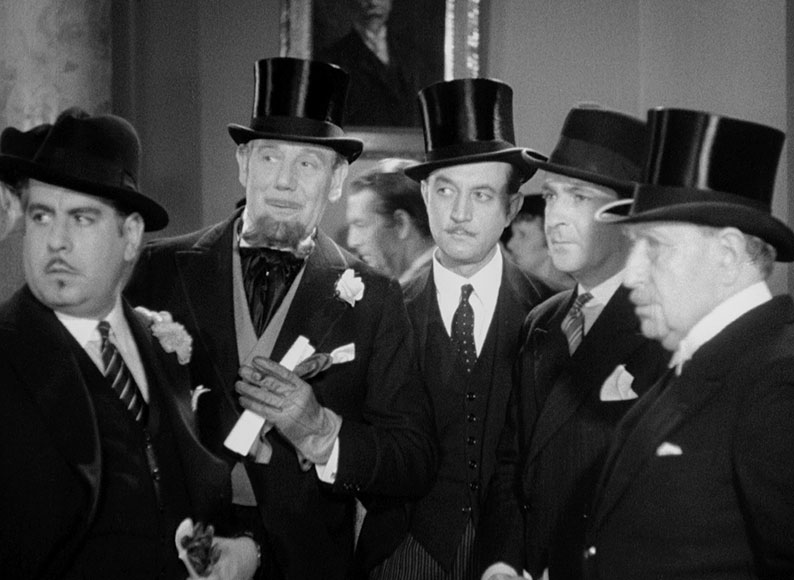
It's an intriguing setup that raises a number of interesting questions. Blake is looking for information on Grant, unaware at this point that an attempt has been made on his life. We know that Larron is up to no good and is clearly the head of a sophisticated criminal gang. Could he be The Snake? Given that Slaughter never plays second fiddle to greater criminal minds, it seems likely. At this point, Blake knows nothing of this, and neither Larron nor Fleming seem aware that Mademoiselle Julie is a secret agent. Does she know who Larron is, or is she just tagging along with Fleming in pursuit of another criminal? And what is the message that Grant whispered into Duvall's ear that he is due to deliver to Blake later that afternoon?
Holmesian elements continue to pepper the narrative when Duvall arrives at the Baker Street flat before Blake gets home and is killed by a poison dart fired at him through an open window. This begins what plays out as a collection of smartly executed moments that are arrived at via clunky plot development. Thus, Duvall gets killed because he suddenly blurts out urgently, "Who opened that window?" and runs over to it to presumably close it, exposing himself to the very danger we can presume he was afraid of. It's a dumb move that is then brilliantly capped. Instead of falling to the ground, Duvall just remains propped up against the frame with his back to the room as if staring outside. Blue Velvet, anyone? Only the fluttering down of a piece of paper that he had in his hand provides the slightest clue as to what has happened. When the truth is discovered and the cops are called, Blake drops a whole series of hints to Bramley that he brushes off with all the idiocy of a giallo detective. After he and his men depart, Baker and Tinker reveal a hidden message on the paper that Duvall was holding using a chemical process of some sort, a message that Baker knew was there because of the clear fluid in Duvall's pen. Neat. Before they suss this, however, Baker distractedly goes to light a cigarette using the very paper in question, which Tinker dopily picked up and placed on the mantlepiece above an open fire and forgot to even mention to Baker. I was actually yelling at the screen at this point.
But these are rare blips in an otherwise well-constructed screenplay by A.R. Rawlinson, adapted from The Mystery of No 13. Caversham Square by Pierre Quiroule. It's engagingly plotted, and the dialogue is often rather smart, and while peppered with preposterous elements, they're no more so than those in the average James Bond movie (Ian Fleming's first Bond novel was still a good 15 years away). Indeed, there's a Bond-like element to Larron's underground lair, and especially his closed-circuit TV system, then future technology predicted with surprising accuracy. The Bondian elements peak with Larron's bemusing decision, after failing to shoot Blake dead and then getting the better of him again, not to kill him after all but tie him to a chair and leave him alone to grab some evidence and be rescued by Julie. As this scene played out, I could hear the voice of Dr. Evil's son Scott from Austin Powers asking his father in exasperation, "Why don't you just shoot him now? I mean, I'll go get a gun. We'll shoot him together." Another sequence involving a casino of mannequins would be at home in an Emma Peel era Avengers episode, and I was amused by the fact that in the later stages Blake is constantly playing catch-up, with the real detective work done by Julie and Tinker.
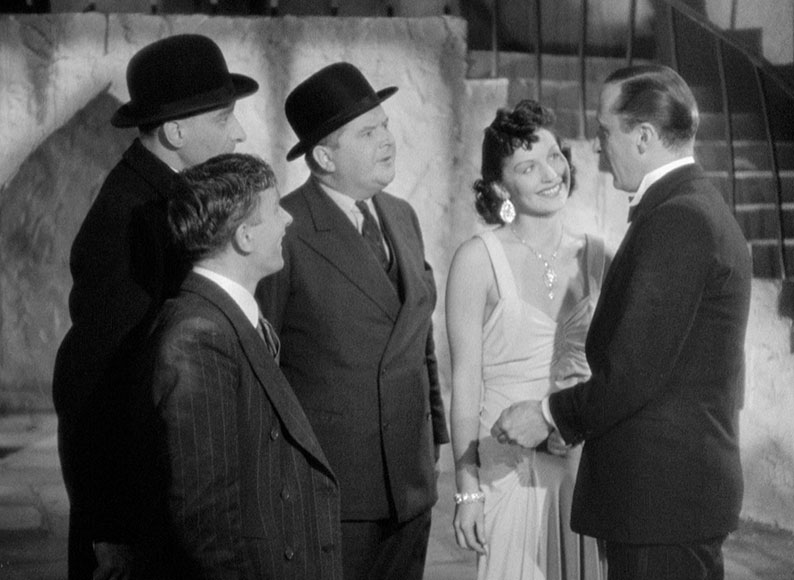
George King once again directs, and he's clearly on a roll by this point, keeping things moving at a belting pace and working with regular cinematographer Hone Glendinning, art director Philip Bawcombe, and editor John Seabourne to make the budget look bigger than it doubtless was. George Curzon makes for an engaging-enough but hardly sparkling Blake, and as the ever-eager Tinker, Tony Sympson really grew on me as the film progressed. But the stars of the show are definitely Greta Gynt as Mademoiselle Julie and our boy, Tod Slaughter, as the villain Larron. There's no sign of his signature barnstorming here, and this may well be his most restrained and impressive performance in this set. I enjoyed the hell out of this one, and given how it ends, a sequel was clearly planned that sadly never made it to the screen. This'll do fine, but I'd love to have had another couple of films featuring this collection of characters.
| THE FACE AT THE WINDOW (1939) |
|
If you're watching these films for the first time in chronological order, the opening scenes of the 1939 The Face at the Window play a little like the overture to Tod Slaughter's Greatest Hits. Despite being based on a stage play by Brooke Warren, it cribs freely from his earlier works, to the point of re-running chunks of their narratives and repurposing their characters. Yes, the setting of 1880 Paris is new, as is the news that a series of murders have been committed by a man-monster whose post-murder howls have earned it the name Wolf Man. And if you're wondering about that title, the face in question belongs to this creature, who appears at the window of its victims before dispatching them. That aside, see if any of the following paragraph has a familiar ring.
Young and pretty Cecile de Brisson (Marjorie Taylor) is in love with the handsome but financially strapped Lucien Cortier (John Warwick), who works as a clerk at a small bank owned by Cecile's father, Monsieur Brisson (Aubrey Mallalieu). When the bank is robbed and one of its employees is murdered by the Wolf Man, its financial future looks grim until the wealthy Chevalier del Gardo (Tod Slaughter) offers to deposit a sizeable amount of gold in its vaults. There's just one thing. He has had his eye on Cecile and wants to marry her, and should this not prove agreeable to M. Brisson, well, he could always take his gold elsewhere. Despite initially sticking up for Cecile, Brisson crumbles and reluctantly agrees to let del Gardo court her, which doesn't sit at all well with Cecile at all. She fights del Gardo off when he tries to force himself on her, and when she pledges her love for Lucien, del Gardo politely salutes her devotion and agrees to stand aside. He then makes immediate plans to fit Lucien up for the robbery of the bank and the murder of his colleague.
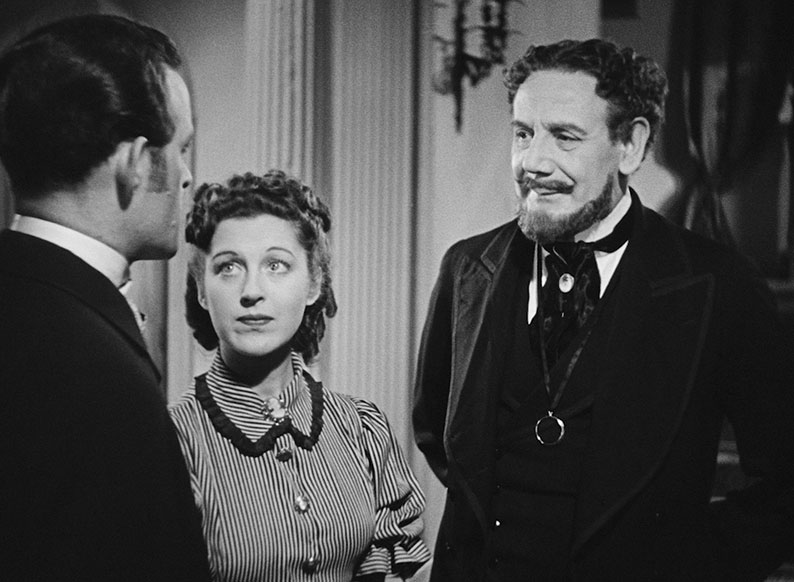
Yep, once again the middle-aged Slaughter is lusting after a woman half his age who is in love with a younger, better looking and altogether more decent man, whom he quickly makes moves to remove from the picture by planting evidence on him of a crime that he didn't commit. It's The Ticket of Leave Man all over again, complete with the exact same trio of lead actors. And who is this stout-looking representative of the Paris gendarme? Why, it's Monsieur Gouffert, the French equivalent of the earlier film's Hawkshaw, also played by that film's Robert Adair. The wrongly accused Lucien, of course, is determined to prove his innocence and unmask the real killer, who he is eventually given good reason to suspect is the lascivious del Gardo. And despite the increasingly mounting (circumstantial) evidence against him, Cecile never wavers in her belief in her man, despite del Gardo's determination to make her his wife.
While this is by now the de rigueur setup for a Tod Slaughter movie, much of what subsequently unfolds and a good deal of the texturing takes us into what for Slaughter was interesting new territory. It may kick off as a murder melodrama, but it's not long before signs appear that the film is expanding into secondary genres. The first comes in the shape of Lucien's friend, Professor le Blanc (Wallace Evennett), a scientist who has spent years experimenting with electricity with the aim of restoring life to dead animals. He claims to now be close to succeeding, but it's a big bloody leap from shocking a dead rabbit into twitching its leg to extracting the true identity of The Wolf from the corpse of his next victim. "And they dare call me mad," he proclaims defiantly. You don't say. What immediately feels like Chekov's Science Experiment briefly moves the film into classic Universal horror territory, seemingly confirmed by le Blanc's Frankenstein-like claim to Lucien that, "Electricity is life!" The professor is then put on hold until the climax requires the results of his scientific endeavours to be put to narrative use.
Then there's titular face at the window, and if you've been patiently waiting five films for Slaughter's reputation as Britain's first horror star to be justified, it's here that it's finally rewarded. And it's as creepy an image as you'll find in a genre work of the period from either side of the Atlantic. It also throws a spanner into the natural assumption that del Gardo is The Wolf. If he is, he's going to an awful lot of trouble with his makeup, and if he isn't, could we have two monsters on the prowl, and could one ultimately fall victim to the other? That's not for me to say, but evidence soon emerges of a possible link between the two, as if you cross del Gardo or get in the way of his plans, you're likely to be seeing a face at your window and be found face down with a knife in your back.
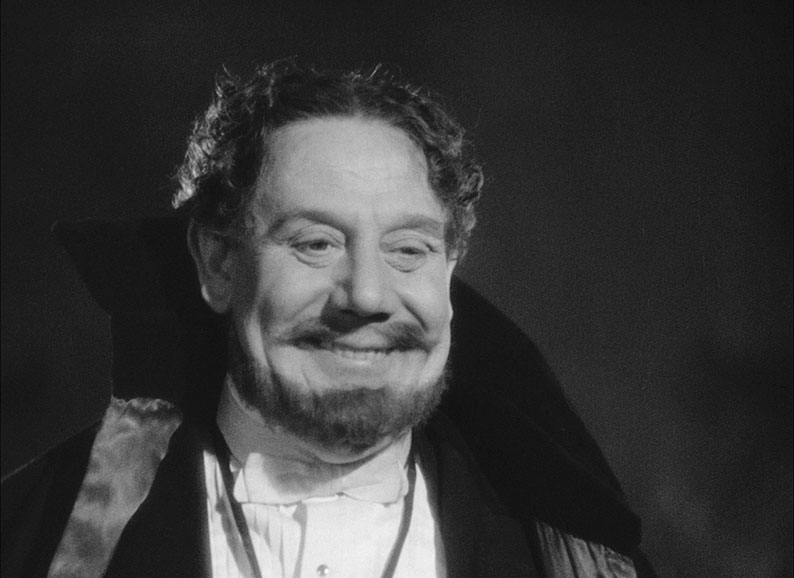
There are further surprises in store. I was certainly caught out when del Gardo and Lucien decide at one point to settle their differences by fighting a duel with pistols. In this, Lucien is seconded by his dandyish peacock of a friend, Pierre, who's played by the too-perfectly named Billy Shine. I was less surprised when del Gardo has his goons (one of whom is played by an uncredited Graham Soutten, the one-legged actor who had roles in two of Slaughter's previous films) knock Lucien to the ground before he can fire and tie him up. As they restrain him, del Gardo gloatingly tells him what he's going to do to Cecile, handily revealing where he's heading next as he does so. He then casually orders his men to take Lucien away, and when they ask where to, the sublime way that Slaughter says "The river" had me laughing out loud. It's one of those rare moments when the delivery alone tells its own story, with the tone of Slaughter's voice not only confirming del Gardo's level of weary contempt for Lucien, but also subtly suggesting that he is far from the first man that the boys have been ordered to dump in the Seine.
And then there's The Blind Rat, a lively basement bar in which del Gardo occasionally conducts his business. It's run with real authority by a woman named La Pinan (Margaret Yarde), whose shoulder pads and back bow deserve their own postal code. Although presented as a den of iniquity and criminality for the censor, it seems obvious now that it's also a brothel and that La Pinan is its Madam. Indeed, there's a dialogue exchange between her and del Gardo that suggests that he occasionally supplies her with young girls who are then doubtless pressured into prostitution. Nowhere is this inference more evident than the scene in which Cecile is tricked into entering the club in search of Lucien. She arrives in plush clothing so out-of-keeping with this location that I was wincing even before she gets through the door. Seconds later, a whole swarm of the club's female workers are all over her, laughing mockingly and pawing at her clothing. Immediately prior to this, La Pinan sees a male customer sitting morosely alone and immediately grabs one of the girls and a bottle of booze and plants both firmly at his table. We get it. The censor at the time presumably did not.
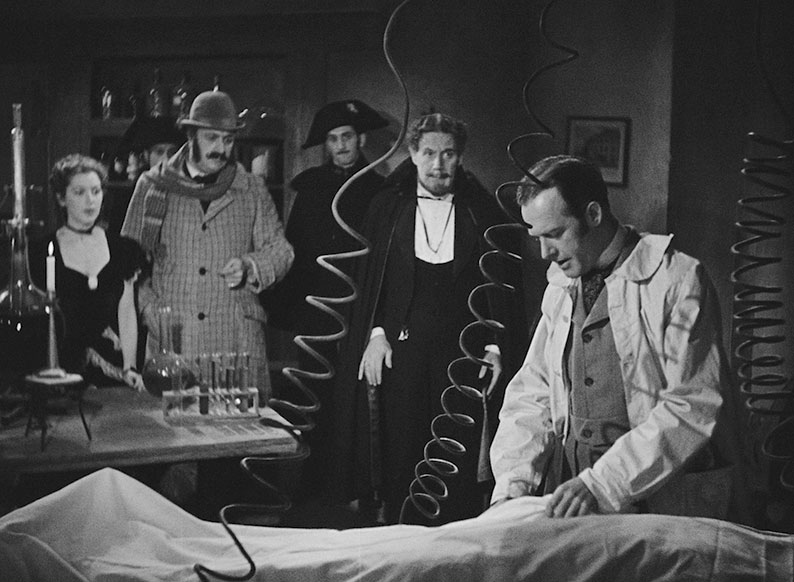
It builds to a climax in which the film's various generic elements all combine in a preposterous but enjoyable (not to mention really well edited) collision of melodrama, science fiction and horror, and a narrative twist that I genuinely hadn't seen coming. George King once again delivers the directorial goods and ensures that the supporting cast is solid enough not to be completely overshadowed by his star. That said, it's a crying shame that the name of the actor who plays the messenger who lures Cecile to The Blind Rat has been lost to history. Physically challenged, cursed with a constant twitch, and jovially confused about just about everything he's asked (or is he?), he's only on screen for a single glorious minute, but makes such a comical impact that he's almost worth the price of admission alone.
| CRIMES AT THE DARK HOUSE (1940) |
|
With the previous three Slaughter films kicking off with a murder, there's a sense that the uncredited director of this last film in the set – whether he be Slaughter regular George King, as often cited, or his protégé David MacDonald as most film scholars now seem to believe – wanted to top them all for gruesomeness. In a tent somewhere in Australia in 1850, Sir Percival Glyde pockets some nuggets that he has presumably uncovered and lays down on his side to get some sleep. As he does so, an unnamed man (Tod Slaughter) sneaks into his tent, then takes a large wooden stake, places it in Glyde's ear and wallops it with a mallet. Bloody hell, that is brutal. All for a few small nuggets of gold. Well, not quite. Also on Glyde's person is a letter informing him that his father has died and that he is the sole heir. If you're quick enough, you'll be able to make out the top half of a line that suggests Glyde has been away in Australia for many years. This, it turns out, is crucial to this mysterious man's plan.
Back in London at Glyde's plush estate, the staff are preparing for their new master's return to the family home, completely unaware that he has been murdered. When he rolls up at the front door, it's clear that Glyde is being impersonated by the man who dispatched him, and as we never learn his real name, I'll be referring to him as Glyde from this point on. He's met by his housekeeper Mrs. Bullen (Margaret Yarde), and quickly establishes that none of the present staff were at the house when the real Glyde headed off to Australia, reducing the chance that anyone will twig that he's not the real deal. When he meets the staff, one particular expectation is met and then immediately toyed with. As soon as he lays eyes on pretty young Jessica (Rita Grant), a look crosses Glyde's face that betrays his lust for her. He even licks his lips a little, for heaven's sake! This time, however, Jessica is not already in love with someone younger and better looking, and clearly rather fancies her employer. What, this guy? It has to be his money and position, right? But don't worry, we're not far away from seeing convention re-established.
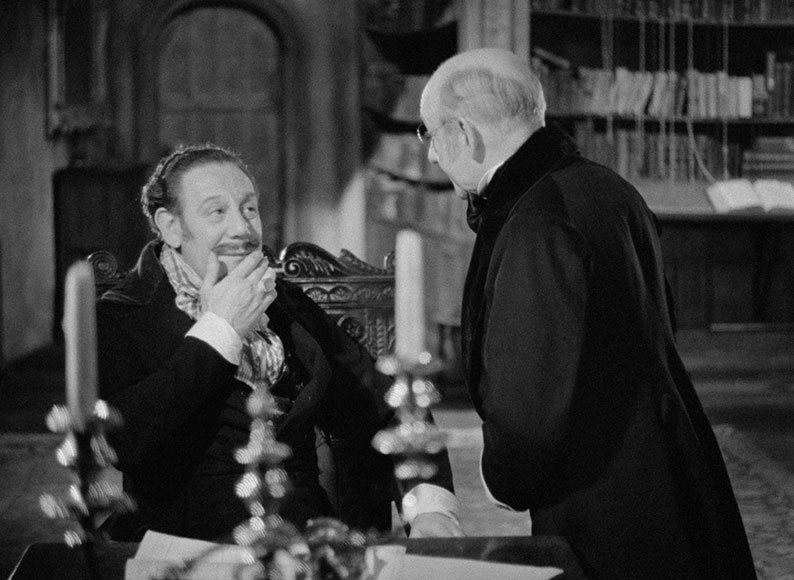
Glyde then has to meet his lawyer, Mr. Merriman (David Keir), to discuss the details of his inheritance. He'd rather not, since Merriman is one person who did know the real Glyde before he left for Australia, but has reached an age where he can't completely trust his memory so quickly accepts the fake Glyde's bluff. Glyde is then hit with an unfortunate but – for us at least – hilarious irony. Having murdered the real Glyde and presumably spent those nuggets on dressing himself up and transporting himself to England to impersonate the man in order to inherit his father's fortune, he is informed that the entire estate has been mortgaged and that he has been left with over £5,000 of debt. Glyde responds by losing his rag in frustration, which you'll be pleased to know becomes a recurring motif in this particular story. It's then that Merriman reveals a way for Glyde to clear his debts and line his pockets. It was apparently his fake father's dearest wish that his son should marry Laura (Sylvia Marriott), the niece and ward of his close friend Frederick Fairlie (David Horne). In true Slaughter fashion, Glyde's first question is to ask whether she is young and comely. She's certainly the former, having only just come of age. Aha, here we go. The key point that Merriman is trying to make, however, is that Laura's late father left her the then eye-watering sum of £100,000 in his will.
Ah yes, Frederick Farlie. If you thought Tod Slaughter was a barnstormer, just wait until you see how much scenery actor David Horne chews his way through as Laura's uncle. You can tell from the blanket covering his legs and the myriad of medicine bottles on his chairside table that he is an unwell man, but boy is he milking it for wildly animated self-pity. While his butler attends to him, the far more pleasant Laura works on a painting, while her sister Marian (Hilary Eaves) offers encouragement and remarks that their uncle has never been pleased by anything they do. As if to underline her point, her handsome young art instructor Paul Hartwright (Geoffrey Wardwell) then enters, shows the painting to Farlie and suggests it shows some talent. Farlie responds in agitation, "Well, it shows up, in a marked degree, the young lady's sad defects, and that these lessons are a waste of time and money!" He then sends everyone away except Laura, whom he reminds of his father's wish that she should marry the son of the late Felix Glyde. The expression on her face clearly betrays her dismay at the prospect, and she hasn't even met the slimy bastard yet. We soon find out the real reason for her unhappiness when it's revealed that she and the somewhat stiff Paul are in love. At last the stars align, and all is right in the Tod Slaughter narrative universe again.
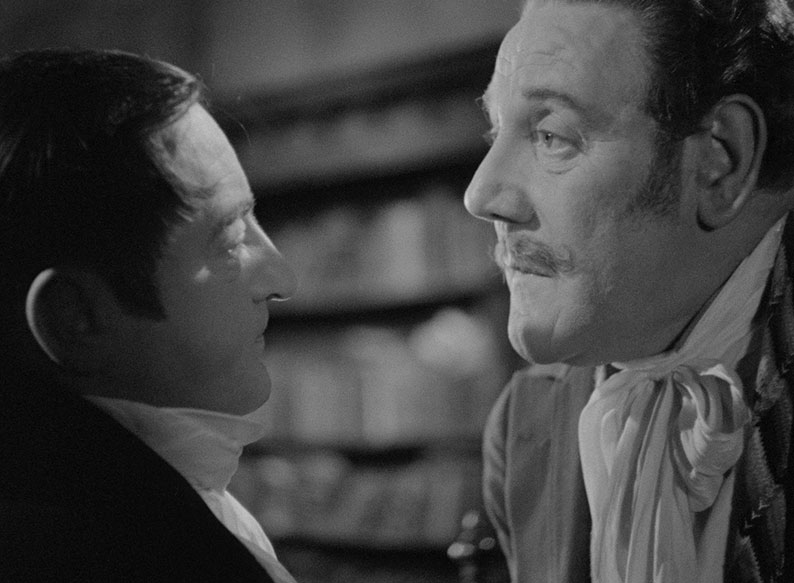
Glyde is then visited by Dr. Isidoe Fosco (Hay Petrie) and a widow-dressed woman named Mrs. Catherick (Elsie Wagstaff). Fosco reminds Glyde that many years ago he had an affair with Mrs. Catherick, one that resulted in the birth of a daughter eight months after he set sail for Australia. Glyde angrily denies the claim and insists he has never set eyes on this woman before. Surprisingly, Mrs. Catherick then withdraws her accusation, not because it was a lie but because she knows full well that the man standing before her is not Percival Glyde. Glyde throws them out, but Fosco engineers a reason to return alone. He reveals that Mrs. Catherick's now beautiful daughter Anne is mentally unbalanced and locked away in his private asylum, and also that she has developed a pathological hatred of her father. You can see a plot twist being set up for later here, but not, I can assure you, what it will be. Fosco clearly knows now that Glyde is an imposter, but doesn't push too hard in what is essentially a blackmail bid, assuring Glyde that he will keep Anne safely locked up as long as the cost of doing so is covered. This amicable arrangement is then complicated when Anne escapes from the asylum and starts making ghostly appearances at the window of the Glyde house before then disappearing again into the night.
Some typical Tod Slaughtering soon follows, but even by his usual standards he's an absolute monster here. When Jessica reveals that she is pregnant with his child and wants him to marry her instead of Laura, he suggests they should elope and tells her to meet him by the spooky old boathouse at night. Oh, Jessica… One very unpleasant murder later, Glyde is free to marry Laura, and my early expectations that this would be prevented by Paul took a jolt when the film cuts straight to Glyde exiting the church and being cheered by the locals, the thoroughly unhappy Laura on his arm. What follows is one of the most torturously unpleasant scenes in all of Slaughter's oeuvre. After the distressed Laura has retired for the night and Marion has been steered to a distant bedroom by Mrs. Bullen, a drunken Glyde slowly makes his way upstairs to the bridal suite. As Laura pulls the bedsheets up to her chin and cries tears of sheer in terror, the melodrama moves into the realm of horror, building gut-wrenching tension out of the prospect of the virginal Laura being raped by her murderous sleazeball of a husband. The scene ends with a fade to black and Slaughter's signature cackle on the soundtrack, as bone-chilling a use his laugh as you'll ever hear. The scene, more than any in this set (and there have been many), had me steaming for the injustice and inequality that women were once forced to suffer and that far too many are still victims of today. I've not read Wilkie Collins' celebrated and much-filmed source novel, The Woman in White, but I gather this was its key theme. It certainly hits home here.
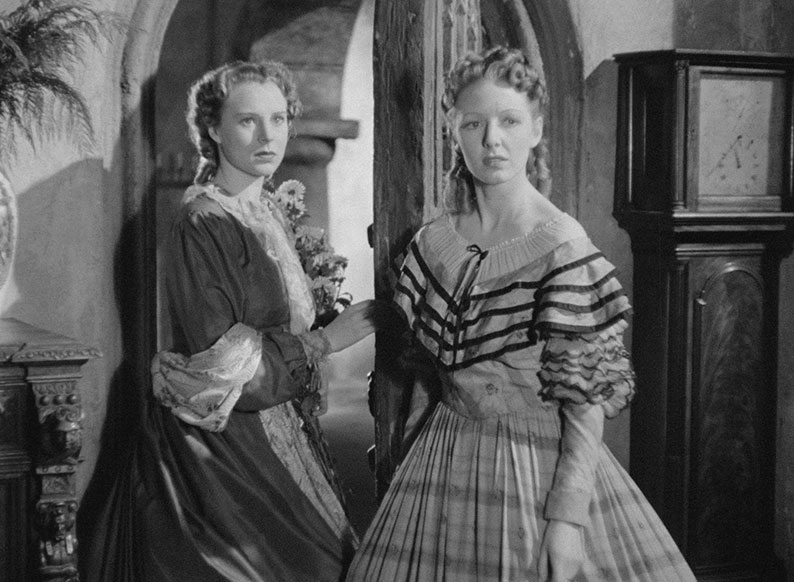
A robust riposte to Glyde's patriarchal sexism is provided by the spirited Marion, who repeatedly stands up to Glyde in defence of her sister. In one of the film's best scenes, she also gives her uncle such a furious talking-to that it prompts his butler to angrily tip all of his master's medicine bottles into his lap and resign on the spot. Indeed, Hilary Eaves' performance as Marion is one of the acting highlights of the film, the other being Hay Petrie, who is a consistent delight as Dr. Fosco in a turn that has more than a ring of Claude Rains at his most playful about it. As Paul, Geoffrey Wardwell initially comes across as the dullest young male lead in this whole box set, but he livens up considerably when bluffing his way into the asylum under the guise of Anne Catherick's lawyer. Finally, there's Slaughter himself, who appears to be having the time of his life here, cackling with glee at his every foul deed, and once even turning to point at the corpse of one of his victims as he does so. He does a nice line in self-important pompousness for show to others, but lets rip enjoyably in moments of angry frustration (of which there are many) and goes full barnstorm in the fiery finale. It's also he, often when conversing with the wily Fosco, who provides the film with its more humorous moments. My favourite, however, comes when lawyer Merriman suggests that the mole that Glyde should have on his right hip would be ample proof his identity, and Glyde response with an furious explosion of outraged bluster, "Damme, sir, are you asking me to remove my trousers?"
<< previous | next >>
Part 1: Inroduction and Films 1-4 | Part 3: Tech Specs, Special Features and Summary
|